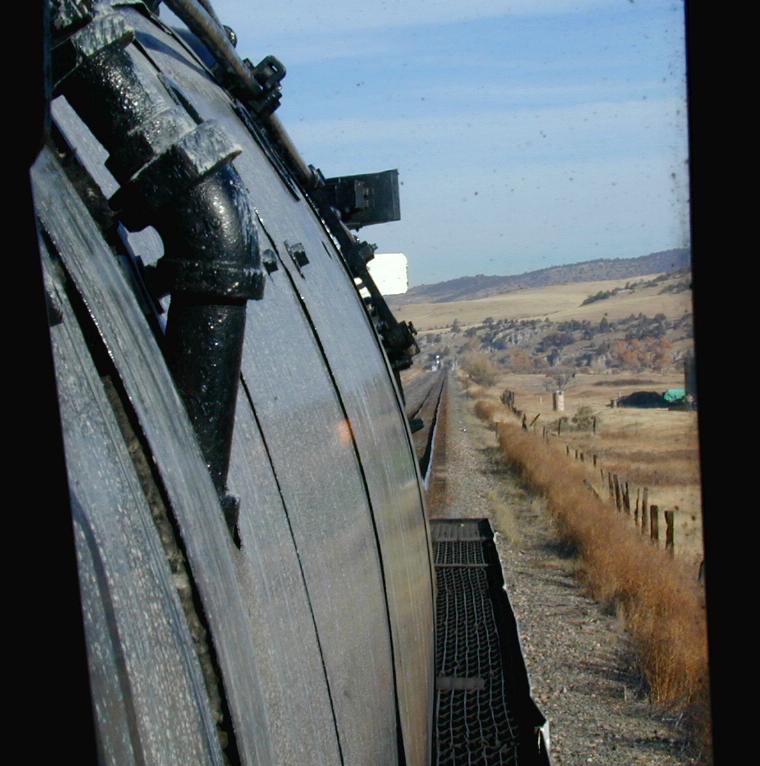
My Run Everyone got back on the train or in the cab and it was time to go. I opened the cylinder cocks and made sure the reverser was down in the corner. I gave two short blasts on the whistle then released both the train air and the loco brakes. Next I opened the throttle about 2 inches. It was harder to operate than I had expected. Watching Jim that morning he seemed to make it look easy. I clasped the throttle release and had to give quite a jerk on the throttle to move it.
Nothing happened. Piteous wisps of steam drifted from the cylinder cocks. We did not move. It didn't get any better.
I opened the throttle another inch or two, again jerking awkwardly on the handle. Steam spewed from the cylinder cocks. This is looking better. But we did not move.
Another inch on the throttle. A jet of steam blasted from the cylinder. We began to move. Easily. Quietly. No diesel revved up. It just moved. WHUFF! Ah, that sounds nice. WHUFF! Steam is hissing from the cylinder cocks. WHUFF... WHUFF... WHUFF. I asked Jim how long to leave the cylinder cocks open. He replied, "Oh about a half dozen revolutions of the drivers". WHUFF WHUFF WHUFF WHUFF WHUFF. Now we are moving several miles per hour. I reached forward and closed the cocks then opened the throttle some more. The 700 surges ahead. The exhaust has changed to the CHUFF CHUFF CHUFF as the rhythm picks up and soon we are moving fast enough even that is truncated to Ch Ch Ch Ch Ch Ch Ch Ch. I give her more throttle and again feel her power. I looked at Jim and he gave me a "widen on her" sign. Ever the passenger engineer that man.
Here is my view out the front window as we depart Clarkston. It is a somewhat telephoto view so the boiler appears shorter than it is.

And the view by hanging out of the side window of the cab.
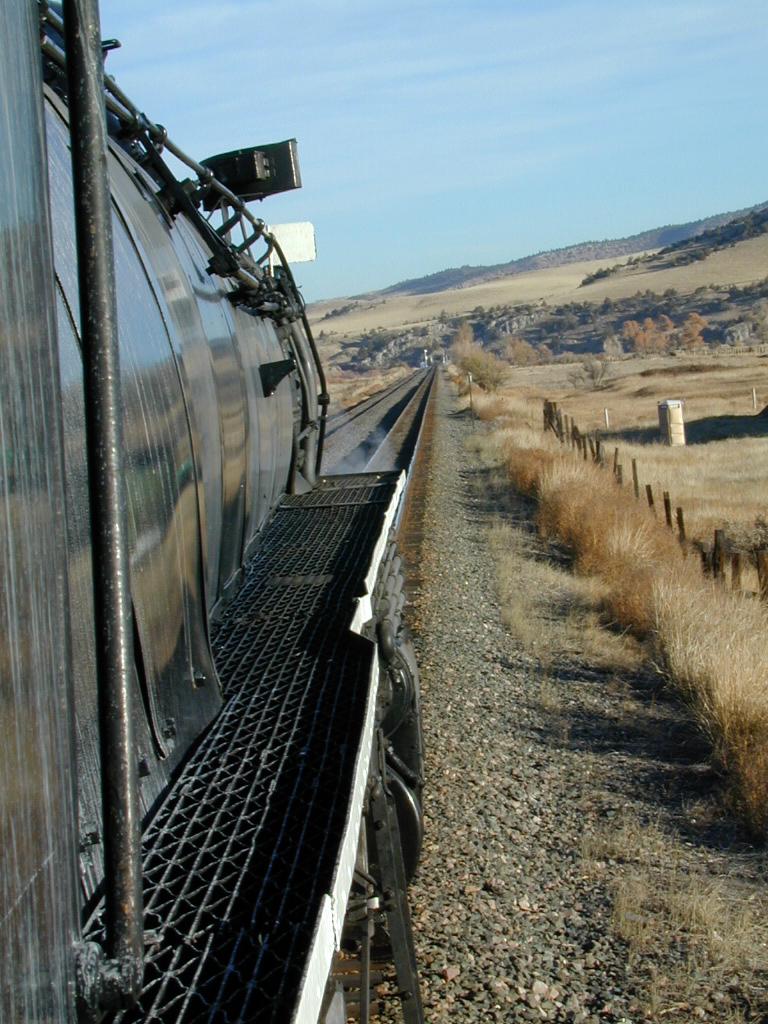
I opened the throttle still more. The cautious freight engineer in me prevents me from really stepping out with her the way Jim does. But each time I open the throttle a little more I feel that surge. Instantly. Even as you are moving the throttle the locomotive responds. There is no delay as diesels rev up and generators load. You want power? You got it, NOW!
Soon we are up to around 30 mph and I looked at the backpressure gauge. Oops! It is almost 35 psi. I grabbed the power reverse lever with my right hand. I squeezed the handle to release the lock. I planned on bringing it back about one third of the way between full forward and center. I was not expecting what happened next.
The instant I released the lock by squeezing the reverser handle it started pushing my hand back. The reverse mechanism was shoving the handle and my hand towards center and then reverse! I leaped at it and put both hands on the handle. I got it stopped just short of center and made sure it was securely latched.
Jim said something like, "I usually move it in 3 or 4 steps". Yeah, well, that was my intention. I hadn't expected it to SHOVE me. Earlier in the day he had showed me a blue mark on the side of the reverser quadrant. He had said they do not like to run her hooked up past that mark as it is harder on the machinery. I looked at the mark. I had stopped the reverser handle just short of it so we were ok.
We were now on the 40 mph track and it was time to slow for the long 25. I reduced throttle, let it settle a few seconds then set the train air. I was careful to bail off the driver brakes before setting the automatic. (Is that the right term, bail off? This loco was built before bails appeared on locomotive brake valves. Is the loco brake referred to as the independent on a steam loco?)
The 8ET brake valve was certainly a novelty to me. I don't think I've ever operated with one before but it is very similar to other valves I've worked with. It is sort of a cross between a 6 and a 24. I made a split reduction of about 10 psi and the train decelerated. I kicked the air off at about 28 mph and we came right out at 25 mph. But the grade got steeper and we quickly dropped to 22 mph so I had to give her a bit more throttle.
We entered the curves at the beginning of the 25 mph track and I don't think there was a straight section longer than 500 feet in the next nine miles. Most of the curves were very tight. The train really dragged through them and I was constantly adjusting the throttle to compensate. It is nice that steam locos have instant response. I can imagine the old steam hogheads' disgust with the delay in loading of the new fangled diesels. They probably didn't like it anymore than I like the slow loading of GEs.
Steve Eshom took these two pictures from the dome car while I was running near Lombard.
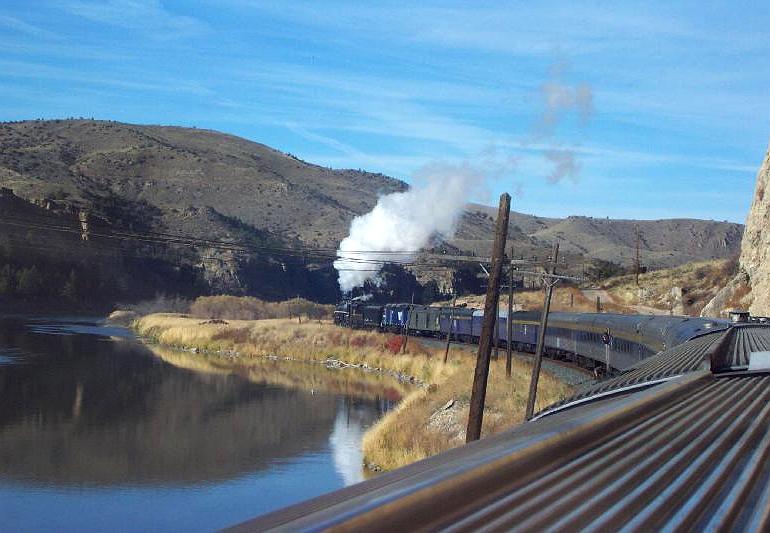
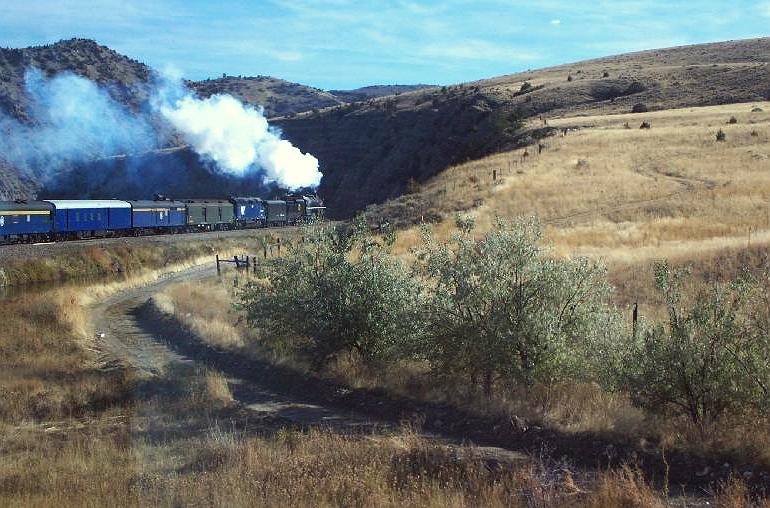
I had noticed earlier in the day that Jim used an awful lot of air braking. That is not to say that he makes deep sets but rather that he makes a lot of air brake applications. "A lot" being relative to my freight train handling experience. I have operated very few passenger trains. I was fireman on a number of them when I worked for Penn Central but I actually ran very few of those. Since then I have been the engineer on perhaps a dozen officers' specials over my career. The last one maybe a dozen years ago. So I don't pretend to be a passenger engineer.
When running freight trains I tend to avoid using air as much as possible. There is always the possibility of a dynamiter and its associated delay. Dynamiters can also break trains in two if the grades and train make up are wrong. On freight trains for short down hill sections you are better off using the throttle to control speed to enter it a bit under the speed limit so the increase does not take you over the speed limit. If you set the air brakes on a freight train to control speed on short down grades you will most likely be way under the speed limit by the time you get it released. Then there is also the fact the railroads do not want engineers power braking anymore. So I am not used to making an air brake set on every little down grade.
In some ways passenger trains are harder to control than freight trains. Short heavy freights "feel" every little change in grade. They quickly accelerate on the down hills and they quickly slow on the up hills. Passenger trains are the same way though not as heavy so not to the same extreme. Longer freight trains tend to average out all the little grade changes over their length.
On the other hand you don't have much slack to worry about on a passenger train and they respond to air brake sets and releases in a fraction of the time of long freights. You also don't have quite as much worry about running out of air using frequent sets since the short trains recharge faster. I would not say one is easier than the other. The two types of trains are just different.
When running on territory that I am intimately familiar with I can control the speed of even short heavy freights very closely. I do it by throttling up or down in advance of the grade change. I know where that won't be enough and I know where to set the air in advance and where to kick it off. But when running on new territory you do not have that advantage. So the only way to do it is to react. Jim's passenger experience serves him well in this situation. He rightly doesn't hesitate to set the train air as the train speed begins to increase. My freight experience works somewhat against me and I was usually playing catch up.
However, even on unfamiliar territory there are some clues that can help. Railroad builders don't like curves. The only reason there are curves is because something is in the way. That is usually a hill. Railroad builders are also cheap. When they build around a hill they don't remove anymore dirt than necessary. That means on most railroads the curves are higher, or less of a down grade, than the straight sections. So coming into curves you need to pull a little harder and leaving the curve you need to back off.
Sharp curves also create flange drag. These sharp curves along the new Missouri presented the double whammy of grade change and curve drag. The train really dragged on the curves requiring throttle adjustments at every one of them. Leaving a curve often required air braking. Sometimes I guessed right and sometimes I guessed wrong and had to catch up.
Speaking of catch up... poor ol' Terry the fireman must have had a time with me. If it had been a coal burner he probably would have beaned me with the scoop shovel half way through my run.
If you get the video of this trip pay close attention to the in-cab shots when Jim is running. It is quite a show to watch the dialog between him and Terry. The dialog is carried out with hand signals and arm gestures. On a steam locomotive every thing the engineer does power-wise affects the fireman. Jim keeps Terry appraised of his intention. If he is about to open the throttle a bit more he signs that intention to Terry. Terry replies and opens up his firing valve a bit to supply the extra steam. If Jim is going to really open up the throttle his gyrations get more animated. Similarly if he is going to reduce throttle he signals Terry in advance.
I found out just how interconnected the engineer and fireman are on a steam locomotive when I took the throttle. When Jim and Terry work together they can keep the stack absolutely clear of smoke. But I had enough to deal with learning to run a steam locomotive pulling a passenger train over new territory without also worrying about my fireman. Terry was on his own. I was not informing him of my intentions because even I did not know what they were. I was playing catch up with the railroad and he was always playing catch up with me. If he doesn't throttle down the fire before I throttle down the engine then black smoke rolls out of the stack. The exhaust steam creates a draft through the firebox and that draft supplies the air necessary to burn the oil. When I throttle down that instantly causes a reduction in the draft and the lack of air causes the excess fuel to turn into smoke. I made a lot of smoke.
After my run I asked Terry if I had worked him pretty hard. He told me that I had kept him pretty busy. I apologized asking forgiveness since it was my first main line steam run. He kindly added, "Oh, I didn't mean it like that". Well I don't know, I think it was a good thing he wasn't shoveling coal.
Terry Thompson keeps the SP&S 700 hot for me.
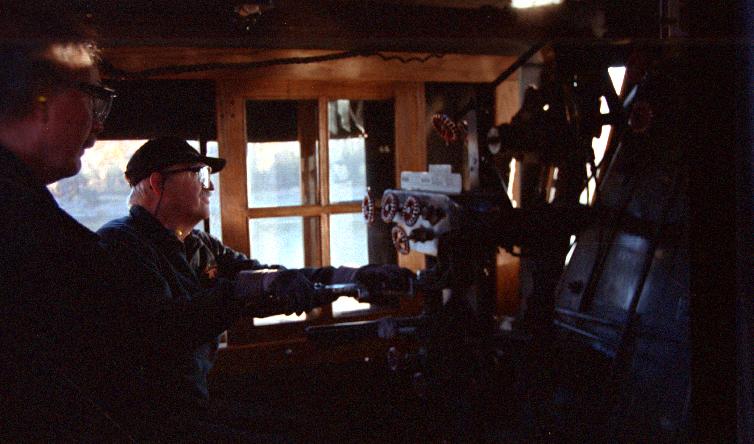
Coming off a particularly sharp curve at one point during my run through the canyon I was working the old girl harder than before. I noticed sprays of water blowing off the top of the boiler from near the stack. Droplets were splattering the small front cab window. My first thought was, am I working water? But I also thought, I am not working her THAT hard. I yelled to Jim who was in the gangway on the fireman's side. He came over and said he and Bob had been watching it on the other side. They thought it might be from the feedwater heater vent. It was definitely not water carry over. It only lasted a mile or two then quit as quickly as it had began.That mini crisis over I was now approaching the "Crystal Ponds". These were some sort of local beauty spot where the tour director wanted the train to slow to 10 mph so the passengers could get a view of them as we passed. From the description I assume they are somewhat similar to the warm springs in Yellowstone Park that have various colored algae growing in crystal clear water. I say "assume" because I never saw them.
Bob was standing in the gangway behind me telling me how far to the 10 mph location. I made a set and slowed the train from 25 mph to 10 mph. I grabbed the power reverse with both hands and shoved it forward to its stop. It seemed easier that time. It must have just caught me off guard the first time.
I used the 8ET brake valve to get a partial release on the cars. That sure is nice. Don't try that with a freight train. I dragged the train past the ponds letting the 700 pull against the brakes. Someone from the left side of the cab hollered at me that the entire train was past so I released the rest of the air and opened the throttle.
Again I was amazed at the instant response as the locomotive and train accelerated. The stack talk got louder and the rhythm faster. We surged ahead and in no time were back up to 25 mph. I moved the power reverse back towards center in a couple of steps. I was getting used to it now and could do it one handed easily. I was also getting used to the throttle. I no longer had to jerk and yank on it to move it. Its operation was smooth and steady. One hand handled it too. Alive as a steam engine may seem I don't think the loco changed characteristics to suit me. So it must have been that I finally found the proper angle and posture to operate it.
Bob asked if I had a camera and I handed him the Nikon digital. He took two pictures of me running the big Northern. Here is one of them. Despite my expression, I assure you that I really was happy.

The next photo was taken by Steven Brown while I was running near Toston Dam.
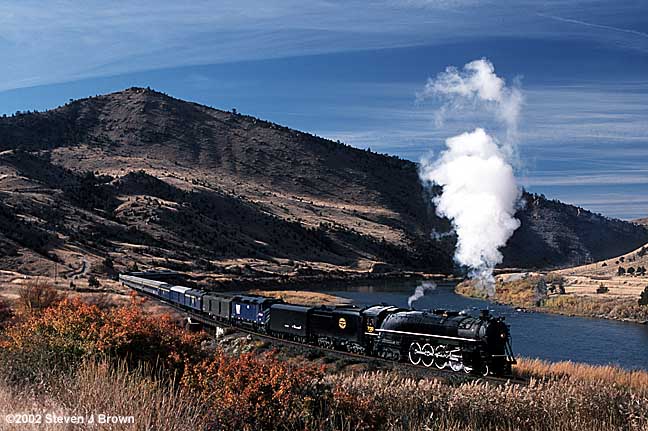
| Return to Tales index | My Home Page | E-Mail me |
Created 10-25-2002
Updated 11-20-2002